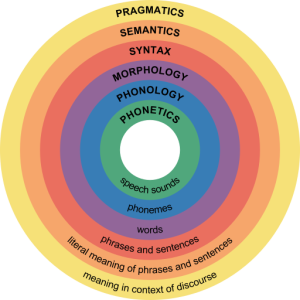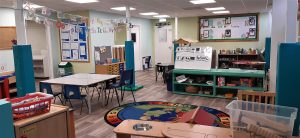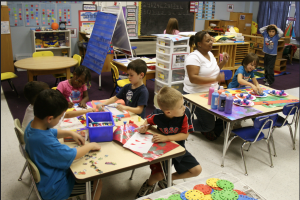4 Oral Language and Emergent Literacy
ESSENTIAL QUESTIONS
- What is the connection between oral and written language?
- How does oral language develop and how can it be fostered in the primary grades?
- What is emergent literacy and its implications for practice?
How Children Become Speakers
The foundation of all literacy is oral language. Long before children experiment with written language through reading and writing, they learn how to use words to communicate. It seems that human beings are genetically destined to learn to speak. Talking is oral expressive language – children express their needs and thoughts. Listening is the auditory receptive language – children receive instructions or information. Oral expressive and receptive language is the foundation of written expressive and receptive language.
There are several theories that seem to explain how humans learn to talk:
The Innatist Theory– this theory of language development says that babies are hard-wired genetically to learn to speak. The human brain has an enormous capacity to acquire and use language. A baby is born with the capability to imitate any speech sound from any language. Some researchers even believe that language learning begins prior to birth as the fetus listens to the speech sounds of the mother’s voice in utero. Newborn babies tend to have an affinity for their own mother’s voice.
The Behaviorist Theory– this theory of language development is tied to the environment and the stimulus and response a child receives. Think of an infant who coos and cries in order to have his or her needs met by caregivers. When a baby babbles and reproduces or imitates a sound like “da da”, a caregiver often reacts very positively to the baby’s attempts and encourages them to keep repeating the sound, “Yes! Da da da! You said da da!”
The Social Interactionist Theory– this theory of language development explains the social nature of humans to interact and learn from each other and is based on the socio-cultural theories of Lev Vygotsky. Most all learning is the result of social interaction and the desire to communicate with others. Babies use gestures and sounds to get their meaning across as they interact with others in their environment.
| LANGUAGE LEARNING THEORIES | CENTRAL CONCEPTS |
| Innatist |
People are hard-wired to learn to speak right from birth. It is part of the DNA as humans. |
| Behaviorist |
Learning to talk is a conditioned response that occurs as babies are rewarded for attempts to make sounds and form words. |
| Social Interactionist |
Children learn to talk from interacting with adults in their environment as they imitate and build on their prior knowledge. |
The Components of Language

Every spoken and written language, including English, is made up of four linguistic components that explain how we use sounds, words and sentences to communicate when talking, writing, listening, or reading. As teachers, it is important to understand the basic building blocks or components of all languages.
Phonology – This is the sound system of language. Every language consists of a series of sounds called phonemes. English has only 44 individual sounds that can be combined in various ways to form thousands of words. For example, picture a small furry animal that says meow and then think of the three sounds that make up the word for that animal. You probably thought of /c/ /a/ /t/ and made the word “cat” in your mind. So in order to speak, we need to know which sounds to use and how to combine them to form words.
Syntax – This is the grammar or rules of language that help us form sentences and full thoughts. Every language has syntactic rules that govern how words are combined. For instance, in English, it is typical to place an adjective in front of a noun, while in French, the adjective would come after the noun. So saying, “The dog big barked” in English would not fit the syntax of the language.
Semantics – This is the meaning component of language. Each and every word carries a meaning or even multiple meanings. Think of how many different meanings there are for the word “blue”. The meaning of a word can be changed by adding an inflectional ending like “s”, “ed”, or “ing”. It changes the tense or timing of the word. Think about the semantics of talk, talks, talked, and talking. They all have a slightly different meaning and when each is used depends on syntax too.
Pragmatics – This is the way language is used to communicate depending on the context. This is the social aspect of language and how we communicate with others to greet, inform, demand, or request. Children talk differently on the playground than in the classroom, just as adults talk differently to an animal or a baby than to another adult. Children begin to learn the pragmatics of language when they figure out how what language is acceptable when speaking face-to-face vs. through text, how to appeal for an extension on bedtime, or how to take turns in a conversation.
Ways to Promote Oral Language Development in the Early Grades
In Kindergarten through second-grade classrooms, it is very important that teachers offer children ample opportunities to continue to develop their use of the components of language in authentic and engaging activities that foster language development and use. A strong foundation in oral language will lead directly to enhanced success in the acquisition and use of written language.

Dramatic Play Centers and Puppets – Teachers can encourage children’s use of syntax, semantics, and pragmatics by having students act out familiar stories like Where The Wild Things Are by Maurice Sendak. Paper bags or socks can easily be created into the characters from Goldilocks and the Three Bears, or The Very Hungry Caterpillar, by Eric Carle. A housekeeping center naturally encourages oral language and the use of the language components as children interact socially and use their imaginations to role-play.

Show & Tell and Sharing Time – When children are encouraged to bring a favorite object to school to share and describe in an organized sharing time, they get to use all the components of language which grows and develops their oral communication both as the presenter and as the audience member. Teachers can enhance the oral language exchange by teaching students how to use complete sentences and how to ask questions. Guessing games like 20 Questions can also be a valuable opportunity to help children develop their speaking and listening skills.
Morning Meeting – Beginning each morning with a routine that includes greeting the children, sharing important events, a short group activity, and a morning message, is a great way to encourage oral language development and review content. Plus, it creates a sense of community.
- Strategy One: Adapt Activities to Include Authentic Talk
- Strategy Two: Use Activities that Develop Strong Language
- Strategy Three: Use Strong Discussion Prompts
Emergent Literacy
At the same time that a child is developing oral language abilities, they are also exploring the functions of written or printed language. Toddlers and preschoolers often imitate an adult’s literacy behaviors by holding a book and pretending to read the story, vocalizing what they see happening in pictures in books, or making scribbled shopping lists or notes to a pretend friend. All of these early attempts at using written language are known as emergent literacy, a term coined by literacy researcher, Marie Clay, to explain how conventional literacy develops. All of the reading and writing-like behaviors that young children display are actually helping them to learn a great deal about how written language works. When young children experiment and play with reading and writing, they are developing foundational knowledge about the functions of print, called Concepts About Print (CAP). In fact, children can gain deep understandings about written language from observing literate others and from being read to frequently. During the emergent literacy phase of development, children learn about three concepts essential to understanding how printed language works.
The Three Concepts About Print:
Directionality – From being read to and even from pretend reading, children develop the understanding that print flows from left to right and top to bottom on the page. When they write their own stories, they realize the same directionality applies and they start at the top left and go to the right and down the page.
Book Orientation (Book Handling Skills) – This is the realization that books have a front and back cover, a title page, pages to turn, an author and illustrator, and a starting and ending point. Even young babies learn to orient chunky board books by adjusting them according to the illustrations.
Letters and Words – This print concept allows children to differentiate between a single letter, a whole word, and a single sentence. Part of this concept also includes recognizing spaces between words, upper and lower-case letters, and different types of punctuation marks.
Primary grade teachers can help children learn about print concepts by modeling, pointing, and tracking print during shared reading of big books, shared writing on large chart paper, interactive writing, and mini-lessons where each concept about print is taught in an engaging and quick activity or game.
Teachers should also create a print-rich learning environment in the classroom by including teacher and student-generated posters along with published printed materials. Student writing journals, a classroom library, a calendar, word labels on classroom places and things, a lunch menu, and a display of classroom jobs all help children understand how print works and is used to communicate.
Teachers should also capitalize on children’s recognition of environmental print and include such items in the classroom often. Environmental print includes all of the letters and numbers found in everyday objects, signs, logos, and products. Cereal boxes, labels, and restaurant signs are all forms of environmental print that children recognize and can “read”. A print-rich classroom and frequent read alouds will help children develop their emergent literacy skills and concepts about print.
Review and Questions to Ponder
Questions to Ponder
- What kinds of literacy-rich dramatic play centers will I include in my future classroom to promote and encourage children to experiment and practice their oral language skills? A post office, general store, veterinarian office?
- What are some of my favorite read aloud books that promote the enjoyment of language? Dr. Seuss, Chicka Chicka Boom Boom, Goodnight Moon?
- How will I use environmental print in my classroom to help children develop print concepts? Cereal boxes, restaurant logos, even candy wrappers?

